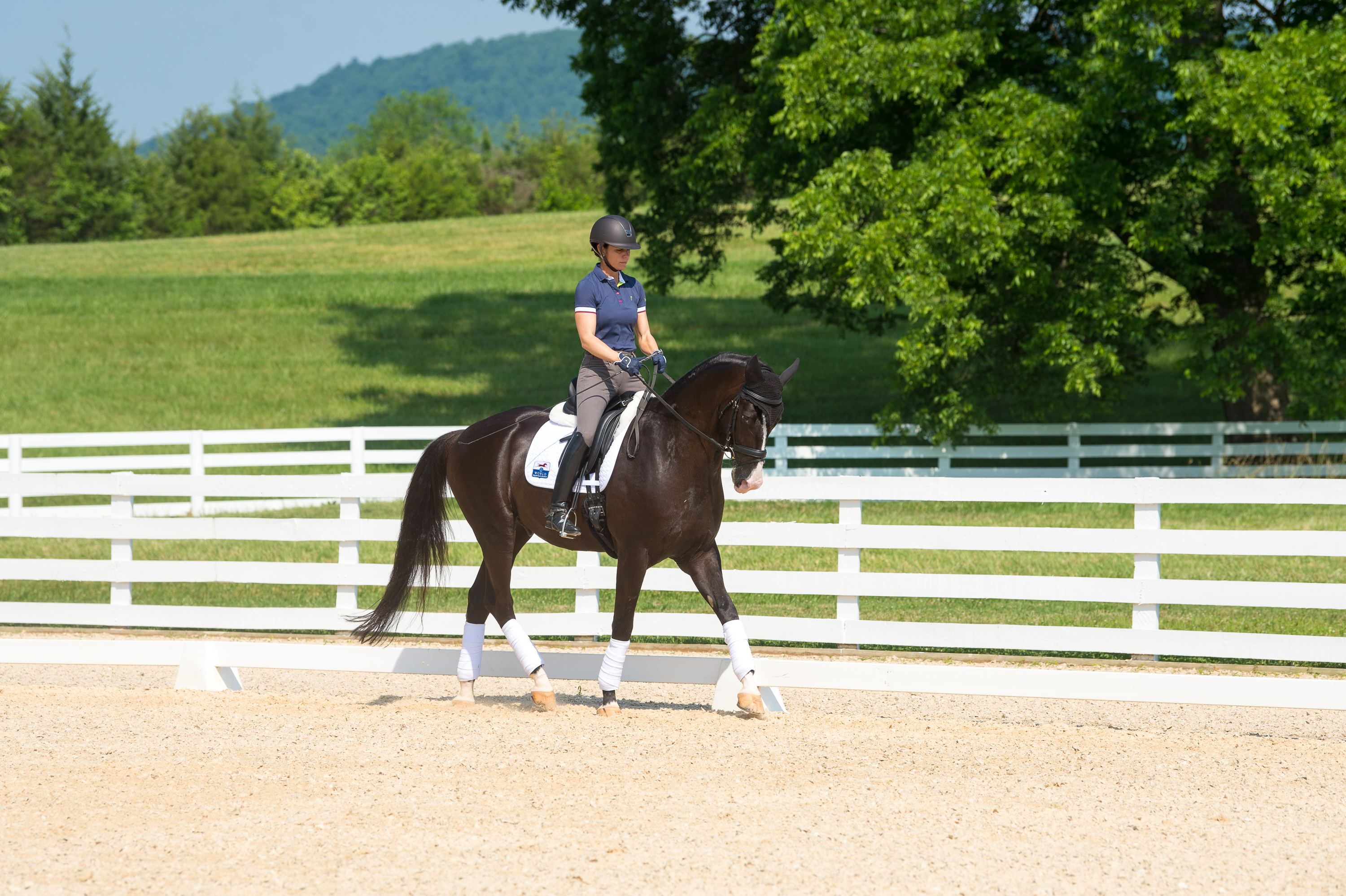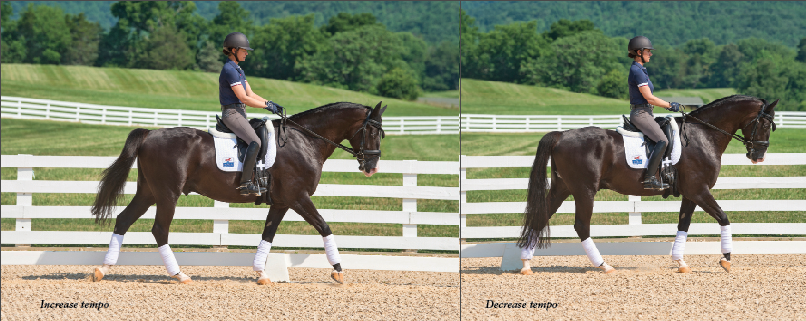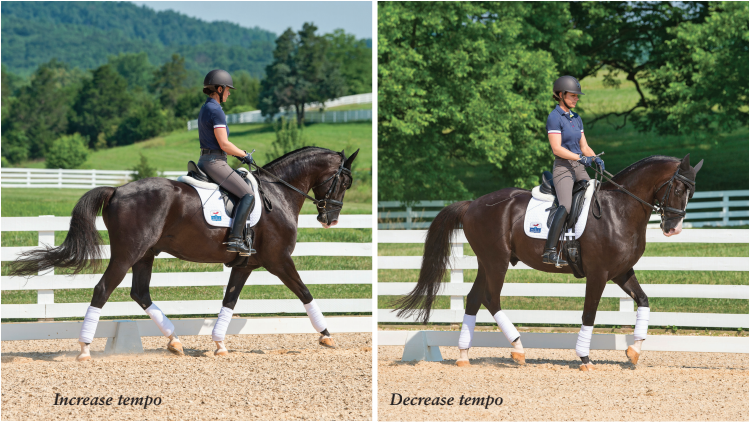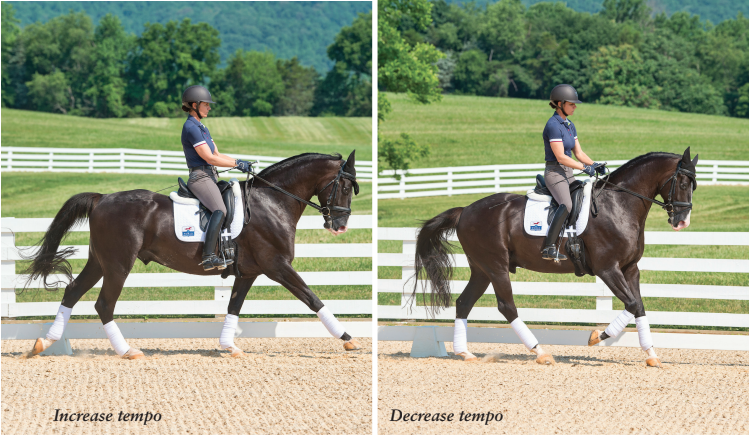In the first part of this two-part series, which appeared in the Fall 2019 issue, I clarified the difference between the commonly confused terms “rhythm” and “tempo.” (Click here to read it.) As I explained, rhythm describes the footfalls, or beats, of a gait, while tempo describes the speed of those beats—how slowly or quickly the hooves strike the ground. In the first article, I offered a few tips and exercises for evaluating and improving your rhythm. In this article, I’ll do the same for tempo.

Tempo: Control the Beat
The awareness we talked about developing to monitor your horse’s rhythm in Part 1 of this series will also come in handy when evaluating his tempo. There is no single, ideal tempo that suits all horses. The best tempo for your horse at any given moment depends entirely on how he feels underneath you.
To determine whether you have the right tempo, whatever gait you’re in, ask yourself, “What could I do from here?” Do you have enough balance, forward momentum and connection to perform any transition or movement you choose? For example, if you’re riding a working trot, could you easily make a transition to canter? To halt? If you’re cantering, could you easily collect the canter? Could you half-pass or do a flying change?
If you realize you’d have to make a massive change to your current gait to perform a movement or go faster or slower, then you’re not in the right tempo. If you’re cantering and can’t imagine being able to perform a half-pass because it feels as if your horse is running the Kentucky Derby, you need to slow him down. If you imagine he’d stop if you asked for a flying change, you need to ask for a little more quickness.
Many riders mistakenly believe that their job is to follow the horse’s tempo. Not so! It’s your horse’s job to follow the tempo that you set. When my students complain that their horses constantly slow down, I point out to them, “Of course he’s going to slow down, because you’re slowing down. You’re doing what he wants you to do!” Instead, you have to switch your thinking and say to your horse, “No, no, you are going to follow me. I’m the one marking the tempo with my seat.”
To take control of the tempo, you first need a few things: 1) the ability to use your seat, hands and legs all independently of one another, and 2) unlocked hips and grip-free knees and thighs. If your hips are locked or you’re gripping your legs onto your horse to try to stick to him, you lose the suppleness necessary to set the tempo and ask him to follow it.
What you don’t need to influence your horse’s tempo is tremendous size or strength. You can be very small and still be incredibly effective. Even the biggest, strongest horses notice what you’re doing with your seat. It just takes practice to train your body to send the right messages at the right moments.
Control the Walk Tempo

Starting at a medium walk, I increase my lower-leg pressure to ask Cherry to quicken his tempo and lengthen his stride, being careful not to tense my seat. To decrease tempo:
To slow the tempo and collect the walk, I gently slow and shorten the swing of my seat (without stiffening in the saddle) and make
a half-halt by closing the fingers on my outside hand.
As I mentioned in Part 1 of this series, pushing or driving with your seat at the walk in an effort to speed it up risks making your horse tense. If he’s not forward enough, the first thing you should ask yourself is: “Am I tight somewhere? Am I holding on with my thighs? Is the weight on the front of my thighs (incorrect) or the back (correct)?” Your hips and pelvis should be following each step with a soft motion in the direction from the back of the saddle toward the front, as if you were gently scooping something off the surface of the saddle. Practicing the leg-loosener exercise I described in the rhythm article is one way to check for tightness. A good ground person can help as well.
Once you’ve confirmed that you’re loose in your hips and sitting on your tailbone in a relaxed way, ask your horse to go forward by closing your upper calves on his sides without tightening anywhere else in your body. Think of this like riding a bicycle: You won’t go any faster if you move your upper body violently. The only way to go faster is to pedal harder.
To decrease the walk tempo, slow your seat motion. Don’t allow your hips and pelvis to follow your horse’s entire movement. Instead, make only half the normal “scoop” in the saddle. If he doesn’t respond to this, apply a half-halt: Close the fingers of your outside hand around the rein for just a single beat and then let go. If he doesn’t respond to that, ride all the way to the halt. This will tune him in to your half-halt aid. Never try holding the half-halt aid for longer than one beat. To be able to influence the step, you need to be able to apply the aid in that single beat and then let go.

Control the Trot Tempo

To ask for a quicker tempo and longer stride at the rising trot, I speed up my posting, while also adding more lower leg pressure each time I sit.
To decrease tempo (right):
To slow the tempo and shorten the stride, I slow my posting and make a half-halt with my outside hand. There is no backwards-pulling motion in the half-halt, just a stabilized, closing hand on the rein as I engage my core. I do not want to shorten my horse’s neck when influencing the length of the step or the tempo.
To increase the tempo at the rising trot, merely post up and down faster while also putting your leg on to ask your horse to follow you. Each time you sit in the saddle, squeeze your upper calves on his sides to encourage him to catch up to you. I promise: This works!
To decrease the tempo in rising trot, simply do the opposite: Slow down your posting. Sit just a split second more with each beat and stay in the air just a bit longer. Act like you’re riding in slow motion and wait for your horse to say, “It would be a lot easier for me to just follow my rider instead of trying to be out of sync with her.” If you try this for a while and still don’t seem to be getting through to him, back your seat aid up with a half-halt. Close your outside hand during the down beat when you’re sitting in the saddle, then open it again as you post.
Similarly, in the sitting trot, use your seat motion to telegraph the tempo you want. (Note: Although exaggerating the movement in your seat to an extreme degree can create tension in any gait, the small exaggerations I suggest here won’t negatively impact the trot or canter the way they can in the walk. The walk is particularly vulnerable to tension in the rider’s seat, upper leg and hands.) Feel how your pelvis rotates with each step, allowing your tailbone to swing under your body with the horse’s motion. To increase the tempo, fractionally increase the quickness of your seat swing. At the same time, apply your driving leg aid to say, “Come on, you follow me.”
As your dressage education progresses, you’ll learn to use this seat aid to ask for more swing in your horse’s back and lift in his step, for example, in the passage and extended trot. Instead of getting lighter in your seat, you actually drop into your horse’s back a little more. I compare this to dribbling a basketball. To make it bounce higher, you don’t lift your hand higher—that would weaken the bounce. Instead, you press down into the ball a little more firmly with each bounce (see Solutions image here).
To decrease the tempo in the sitting trot, slow down your seat movement as you did in the rising trot. Think, I’m just going to wait here, until your horse says, “OK, I’m going to follow you. That’s easier.” If he doesn’t arrive at that conclusion in a timely enough manner, follow up with a half-halt.
Control the Canter Tempo

To encourage Cherry to speed up the tempo and lengthen his stride at the canter, I increase the swing or “scoop” of my seat. I think of my own tempo in my body speeding up.
To decrease tempo (right):
I shorten my seat “scoop” to ask for a more collected, slower tempo, then apply a follow-up half-halt with my outside rein aid—always being careful not to pull backward on the reins.
The correct seat motion at the canter is similar to the back-to-front swing you felt at the walk. Your hips and pelvis follow the motion of your horse’s footfalls, starting with the outside hind leg and scooping forward toward the inside foreleg, taking your inside hip slightly ahead of your outside hip.
Unlike the walk, where you must rely entirely on your leg to increase the tempo, you can use your seat motion as well to influence the canter. By slightly increasing the RPMs of your “scoops,” you’ll cue your horse to pick up the tempo, just as you did in the trot. Be careful not to push against the saddle, though. This might irritate him and cause him to slow down even further.
As you increase your seat swing, tap your horse’s ribcage with your outside leg in rhythm with his step to encourage him to move his outside hind leg up and down more quickly. Since your inside leg has many other jobs, such as asking for the bend and cueing for a flying change, your horse will find it less confusing if you use only your outside leg to increase the canter tempo. This is the aid he already associates with making the first push-off step with his outside hind leg when he picks up the canter, so it’s more likely to achieve the reaction you want.
To decrease the canter tempo, slow down your seat swing, just as you did in the walk and sitting trot. Instead of following each entire stride with your hips and pelvis, only allow them to swing half as much. Stick to the slower tempo that you want until your horse goes, “This is hard work to not have her with me. I’ll just slow down and follow her.”
As always, if he doesn’t respond to this seat aid, follow up with a half-halt. Close your outside hand on the rein and say, “Whoa,” midway through your seat swing on the second count of the three beats (the “two” in “one-two-three”). That’s the moment when the outside foreleg is on the ground. Your half-halt will stabilize that leg, making your horse pause momentarily until it comes off the ground again.
Once you’ve learned how to find the right tempo at every gait, the next challenge is to maintain it. Counting out loud when you’re riding at home often helps. Verbalize “One-two, one-two” in the trot or “One-two-three, one-two-three” in the canter in the tempo you want your horse to follow. This way, you’ll develop a feeling for that desired tempo much more effectively than if someone were there setting a metronome for you. Until this feeling is ingrained in your mind and body, verbally tell your horse and the universe what tempo you intend to ride.
Over time, you’ll discover that focusing on rhythm and tempo improves the quality of all your dressage work—as well as your marks in the show ring!
This article first appeared in the winter 2019 issue of Practical Horseman magazine.
To read more Dressage Today articles with Ali Brock, click here.
Allison (Ali) Brock grew up in Hawaii, where she was very active in Pony Club, jumped, rode dressage, exercised polo ponies and rode Western. After high school, she moved to the mainland to work with several well-known dressage trainers, including Olympian Sue Blinks. When Sue moved to the West Coast in 2004, Ali took over the head trainer position at Fritz and Claudine Kundrun’s DeerMeadow Farm in Keswick, Virginia. She developed the Kundruns’ now-retired Hanoverian stallion Rosevelt from a 6-year-old to a team bronze medalist at the 2016 Rio Olympics. While bringing along her next stars, she continues to be an active clinician and official ambassador for Brooke USA, a nonprofit organization dedicated to improving the welfare of working horses, mules and donkeys around the world.











